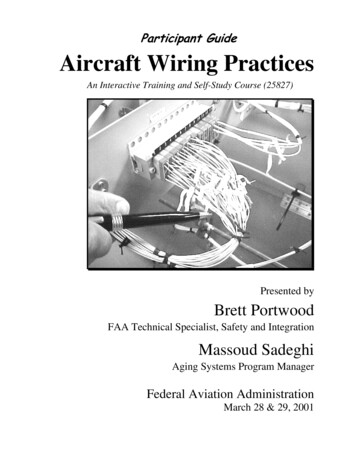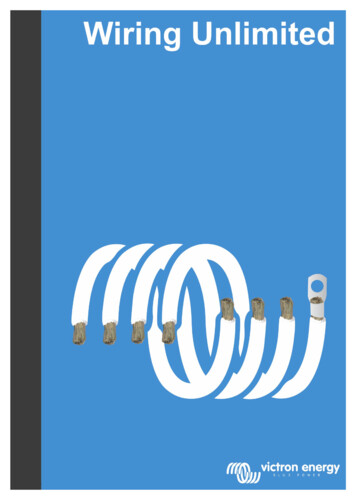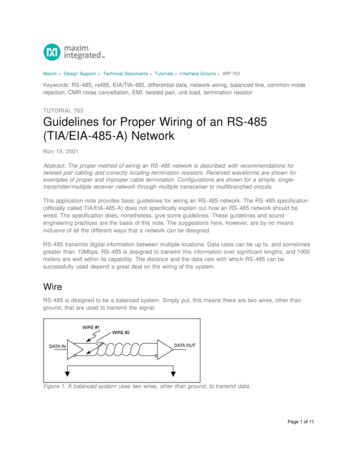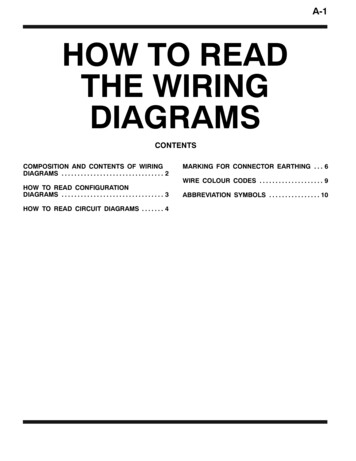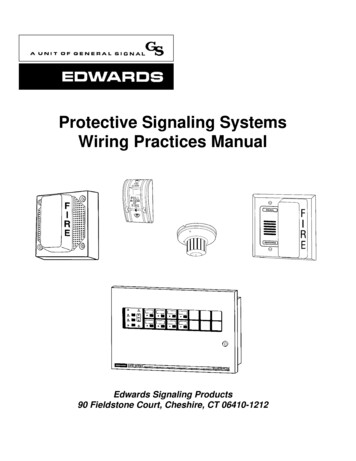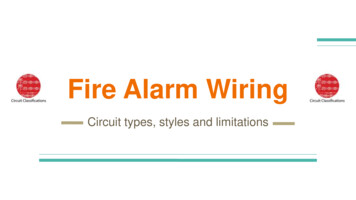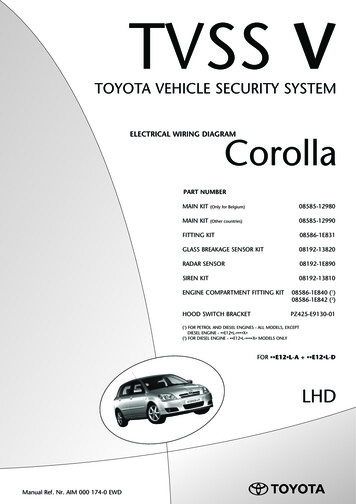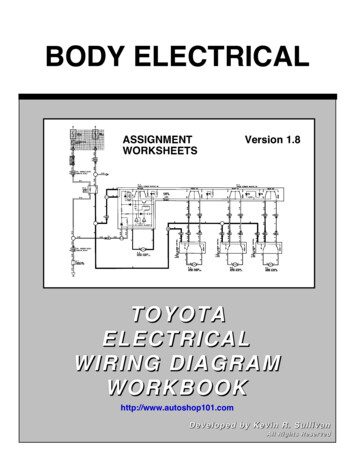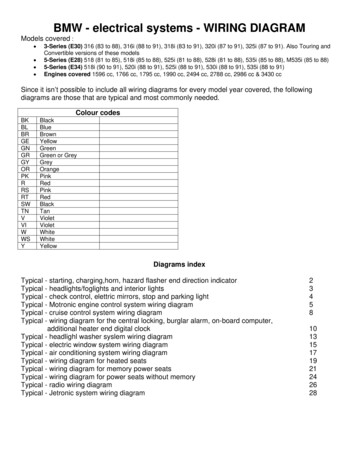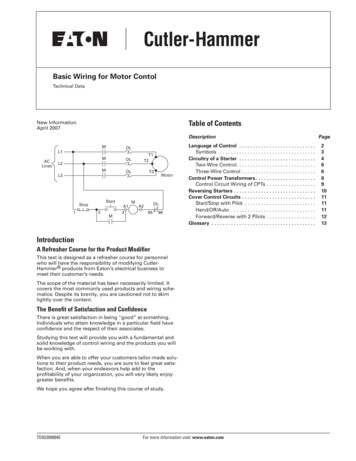
Transcription
Basic Wiring for Motor ContolTechnical DataTable of ContentsNew InformationApril artStop1MA132OLA295M96Language of Control . . . . . . . . . . . . . . . . . . . . . . . . . . . .Symbols . . . . . . . . . . . . . . . . . . . . . . . . . . . . . . . . . . .Circuitry of a Starter . . . . . . . . . . . . . . . . . . . . . . . . . . . .Two-Wire Control. . . . . . . . . . . . . . . . . . . . . . . . . . . . .Three-Wire Control . . . . . . . . . . . . . . . . . . . . . . . . . . .Control Power Transformers . . . . . . . . . . . . . . . . . . . . . .Control Circuit Wiring of CPTs . . . . . . . . . . . . . . . . . .Reversing Starters . . . . . . . . . . . . . . . . . . . . . . . . . . . . . .Cover Control Circuits . . . . . . . . . . . . . . . . . . . . . . . . . . .Start/Stop with Pilot . . . . . . . . . . . . . . . . . . . . . . . . . .Hand/Off/Auto . . . . . . . . . . . . . . . . . . . . . . . . . . . . . . .Forward/Reverse with 2 Pilots . . . . . . . . . . . . . . . . . .Glossary . . . . . . . . . . . . . . . . . . . . . . . . . . . . . . . . . . . . . .IntroductionA Refresher Course for the Product ModifierThis text is designed as a refresher course for personnelwho will have the responsibility of modifying CutlerHammer products from Eaton’s electrical business tomeet their customer’s needs.The scope of the material has been necessarily limited. Itcovers the most commonly used products and wiring schematics. Despite its brevity, you are cautioned not to skimlightly over the content.The Benefit of Satisfaction and ConfidenceThere is great satisfaction in being “good” at something.Individuals who attain knowledge in a particular field haveconfidence and the respect of their associates.Studying this text will provide you with a fundamental andsolid knowledge of control wiring and the products you willbe working with.When you are able to offer your customers tailor-made solutions to their product needs, you are sure to feel great satisfaction. And, when your endeavors help add to theprofitability of your organization, you will very likely enjoygreater benefits.We hope you agree after finishing this course of study.TD03309004EFor more information visit: www.eaton.comPage2346689101111111213
Technical DataPage 2Effective: April 2007Basic Wiring forMotor ContolLanguage of ControlCircuit diagrams communicate information quickly andefficiently.Line diagrams show circuits of the operation of thecontroller.Every trade and profession has its method of communicating ideas and information quickly and efficiently. In additionto the terminology shown in the glossary of this text, diagrams play a vital role of communication in electrical circuits. A knowledge of symbols, diagrams and terminologywill aid in our understanding of electrical control.Line diagrams, also called “schematic” or “elementary” diagrams, show the circuits which form the basic operation ofthe controller. They do not indicate the physical relationships of the various components in the controller. They arean ideal means for troubleshooting a circuit.The basic language of control is the circuit diagram. Consisting of a series of symbols interconnected by lines to indicatethe flow of current to the various components, it tells inremarkably short time a series of events that would takemany words to explain. Circuit diagrams are available in twoformats.Figure 2 shows a typical line or schematic ure 1 is a typical wiring diagram for a three-phase magnetic starter.L1OLL2Wiring diagrams show the connections to the controller.Wiring diagrams, sometimes called “main” or “construction” diagrams, show the actual connection points for thewires to the components and terminals of the controller.They show the relative location of the components. They canbe used as a guide when wiring the controller.ML11MA132MOLA29596Figure 2. Typical Line or Schematic PhaseMotorFigure 1. Typical Wiring DiagramFor more information visit: www.eaton.comTD03309004E
Basic Wiring forMotor ContolTechnical DataEffective: April 2007Page 3SymbolsStandardized symbols make diagrams easier to read.Both line and wiring diagrams are a language of pictures. Itis not difficult to learn the basic symbols. Once you do, youare able to read diagrams quickly, and can often understanda circuit at a glance. The more you work with both line andwiring diagrams, the better you will become in analyzing them.The American Standards Association (ASA) and the NationalElectrical Manufacturers’ Association (NEMA) are the agencies which are responsible for setting up and maintaining thesymbol standards. Because of these standards, you will beable to read all diagrams that come across your workbench.Figure 3 shows many of the most commonly used symbolson Control diagrams.CoilsSingle VoltageMagnet CoilsDual VoltageMagnet CoilsOn Contacts and Switches or Pushbuttons, you will find adesignation of NO or NC (Normally Open or NormallyClosed). This refers to the state of the contacts when poweris not applied to them. In tracing circuits on line diagrams,you will need to visualize the opening or closing of the contacts when the circuit is energized or de-energized.The pushbutton symbols shown in Figure 3 represent“Momentary” pushbuttons. The contacts will change statefrom their normal position only for as long as your finger ison the button.Later in this text, we will be working with actual applicationsand line diagrams. So study these symbols carefully please.RelaysThermalOverload9897OLLink96Reset9512 .C.T.O.1 23 4LowVoltageSwitchesT.O.PushbuttonNormally ClosedPushbuttonContactsNormallyOpenNormally OpenLimit SwitchNormallyOpenNormallyClosedLimit SwitchHeld OpenLimit SwitchNormallyClosedTimedOpenT.O.Limit SwitchHeld eStandardIndicatorLightsStandardMotors haseT1T2Two-WirePilotDevicesT3TransformersLow VoltageControlTransformerH1X1Figure 3. Standard Diagram SymbolsTD03309004EFor more information visit: www.eaton.comPTH2X2
Technical DataPage 4Effective: April 2007Basic Wiring forMotor ContolCircuitry of a StarterThe two circuits of a motor starter are the power and control circuits.There are two circuits to a starter — the Power Circuit andthe Control Circuit.The electricity that passes through the contacts of thestarter, through the overload relay, and out to the motor, iscalled the power circuit. The thick lines of Figure 4 representthis power circuit. It is the power circuit that passes electricity to the motor enabling it to run. For this reason, it is sometimes referred to as the motor circuit.Common Control — power and control circuits at same voltage. Separate Control is at different voltages.The thin lines in Figure 4 represent the control circuit. Themagnet coil of the starter is energized with this circuit, whichcreates the electro-magnetic field that pulls the power circuitcontacts closed.The control circuit is separate from the motor circuit. Thecontrol circuit may not be at the same voltage as the powercircuit. When the voltage of the control and power circuits isthe same, it is referred to as Common Control. If the voltages are different, it is called Separate set953-PhaseMotorSeparate voltages supplied by Control Power Transformers.Another method for supplying separate voltages for powerand control circuits, is to use a Control Power Transformer.These are sometimes also referred to as Control CircuitTransformers. One voltage source is used to supply themotor. This same voltage is also supplied to the primary sideof the transformer. The transformer’s secondary supplies thevoltage to operate the magnet coil in the control circuit. Amore detailed explanation of transformers can be found onPage 8.Common Control is when the power circuit and the controlcircuit are fed from the same voltage source.Common control is when the control circuit is tied back tolines 1 and 2 of of the starter. It is supplied with the samevoltage as the power or motor circuit.The understanding of Common Control and Separate Control becomes significant when changing magnet coils fromone voltage to another.Changing magnet coils from 120V or to 120V involves adding or removing wire “C”.If you stock starters or contactors with different rated magnet coils, and need to convert the device to a 120V magnetcoil for separate control, you must remove the connection tothe power circuit that is provided. Figure 5 shows this connection. Wire “C” is connected to L2 and terminal 96 on theoverload relay in all Cutler-Hammer starters supplied withmagnet coils greater than 120V. You must remove the wire,and then connect the separate control voltage lines to thenumber 1 terminal on the remote pilot device and terminal96 on the overload relay.On the other hand, if you are converting a starter that wasfactory supplied for 120V Separate Control to a CommonControl device, you must put in this jumper.If you are swapping out a 480V magnet coil to supply onewith 240V coil to meet a customer’s needs, you do not needto worry about wire “C”. Only when changing to 120V orless from any voltage greater than 120V or changing to anyvoltage greater than 120V from 120V or less, is thissignificant.Figure 4. Typical Starter Wiring Diagram — Three-PhaseSeparate voltages supplied by different voltage sources.How can you have two different voltages going into thesame starter? One method is to run different wires from different electrical voltage sources. You might have a 480V supply that is attached to the line side of the starter, and thatruns through to the motor. Another set of wires, from a different voltage source would bring 120V to the magnet coil.The coil is energized by the 120V, and the pushbuttons orother control devices operate at this same voltage. Themotor operates at the power circuit voltage, in this case,480V. The coil rating must match the control source voltage,and the starter is sized to match the horsepower and voltageratings of the power circuit.For more information visit: www.eaton.comTD03309004E
Basic Wiring forMotor ContolTechnical DataEffective: April 2007Page 5Circuitry of a StarterCommon Control1/L13/L25/L31A12A2Remote PilotDevicesCì ”M2-Wire Control31983Not for use with AutoReset OL Relays.97OL962/T14/T2Reset6/T3953-Wire ControlSeparate ControlT1T2StartRemove Wire “C” when it issupplied. Connect SeparateControl Lines to the No. 1Terminal on the RemotePilot Device and theTerminal 96 on theOverload Relay.T332Stop3-PhaseMotor1/L1Separate Control 16/T3T2Reset95T33-PhaseMotorFigure 5. Common vs. Separate ControlTD03309004EFor more information visit: www.eaton.com1
Technical DataPage 6Effective: April 2007Basic Wiring forMotor ContolCircuitry of a StarterTwo-Wire ControlTwo-Wire Control circuits — or Low Voltage ReleaseOne of the common control wiring circuits used is known asTwo-Wire or Low Voltage Release (LVR). It utilizes a maintained contact type of pilot device — such as a thermostat,float switch or presence sensor. Figure 6 shows the line andwiring schematics for this circuit.When the maintained contacts on the pilot device are closed,it energizes the coil of the starter, which connects the loadthrough the power circuit. When the contacts of the pilotdevice open, the coil is de-energized, and the starter dropsthe load off line.Automatically restarts when power is restored if pilotdevice is still closed.The circuit provides for an automatic operation of the load.If there is a power outage or loss, the starter will bede-energized. This is why the circuit is often called LowVoltage Release (LVR).1/L13/L25/L311A1A22Two-WirePilot DeviceM3989796OL2/T14/T26/T3T1T2T3If the maintained contacts of the pilot device remain closedduring the power loss or outage — the starter will be reenergized when the power to the control circuit is restored.2Reset95L1Caution must be used in the application of this circuit —there is no personnel safety protection when the power isrestored.L2PD3-PhaseMotor1A1MOLA295396Figure 6. Two-Wire ControlThree-Wire ControlThree-Wire Control circuits — or Low Voltage ProtectionThe other very common control wiring circuit used is knownas Three-Wire or Low Voltage Protection (LVP). This circuitrydoes provide personnel safety protection in the event ofpower loss or outages. It utilizes momentary contact pilotdevices and a holding circuit contact.L1L2L31A1A2This holding circuit, or seal-in circuit, is most commonly provided by an auxiliary contact on the contactor or starter.Figure 7 shows the typical line and wiring diagrams forThree-Wire control circuits.Circuit does NOT automatically restart when power isrestored.This circuitry provides LVR, because if there is a power outage or loss, the starter will be de-energized. But, it providesLow Voltage Protection, because the circuit does not automatically restart. The only way to restart this circuit is tomanually use the START button.Because this circuit is very popular in motor control systems, let’s go through the operation of it -PhaseMotorFigure 7. Three-Wire ControlThe circuit consists of a Normally Closed (NC) STOP buttonwired in series with a Normally Open (NO) START button. ANormally Open (NO) Auxiliary contact on the starter will beused as the holding circuit.For more information visit: www.eaton.comTD03309004E
Basic Wiring forMotor ContolTechnical DataEffective: April 2007Page 7Circuitry of a StarterThree-Wire Control (Continued)When the START button is depressed (Figure 8), it completesthe circuit to energize the coil of the starter. When thatoccurs, the Normally Open (NO) Auxiliary contact closes.This
Typical Wiring Diagram Line diagrams show circuits of the operation of the controller. Line diagrams, also called “schematic” or “elementary” dia-grams, show the circuits which form the basic operation of the controller. They do not indicate the physical relation-ships of the various components in the controller. They are an ideal means for troubleshooting a circuit. Figure 2 shows a .

